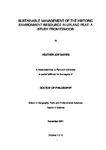Sustainable Management of the Historic Environment Resource in Upland Peat: A Study from Exmoor
| dc.contributor.supervisor | Fyfe, Ralph | |
| dc.contributor.author | Davies, Heather Joy | |
| dc.contributor.other | School of Geography, Earth and Environmental Sciences | en_US |
| dc.date.accessioned | 2012-05-28T10:29:38Z | |
| dc.date.available | 2012-05-28T10:29:38Z | |
| dc.date.issued | 2012 | |
| dc.date.issued | 2012 | |
| dc.identifier | 10135462 | en_US |
| dc.identifier.uri | http://hdl.handle.net/10026.1/1026 | |
| dc.description.abstract |
UK uplands preserve a rich history of human inhabitation and environmental change through standing monuments, archaeological sites, and within peat deposits. Palaeoenvironmental remains within peat can be used to reconstruct environmental histories throughout the Holocene. Small mires in varied topographic locations can allow detailed local landscape reconstruction, setting archaeological sites in environmental context, or building up a picture of the mosaic of changing landscapes through time. Recent moves towards assessing the ecosystem services provided by different landscapes mean that, to make a case for preserving upland peatlands for the palaeoenvironmental remains they preserve, we must be able to demonstrate their archaeological potential or value. This project investigated methods for identifying the extent of this ‘hidden’ resource, as well for assessing its current condition and historic environment value, through the case study of valley, spring and soligenous mires on Exmoor. The lack of known archaeological or material culture remains from upland peatlands in the UK and on Exmoor means that the project focussed solely on the palaeoenvironmental resource. The methods used combined desk-based survey and spatially-extensive walkover survey to assess the overall extent and condition of the palaeoenvironmental resource in mires across Exmoor. Alongside this, a site-based programme of water-table monitoring and coring was undertaken to look at the effects of recent land management practices on the condition of this resource. The results demonstrated that walkover survey and peat depth probing were necessary to define the spatial extent and depth of mires, and assess mire condition. A standardised key was developed to allow the baseline mire condition survey to be repeated. The site-based study demonstrated the negative impact of water-table draw-down on the condition of palaeoenvironmental remains. However, it also demonstrated that a multiproxy approach is necessary to allow the complex palimpsest of the effects of human impact, climate change, and recent damage to mires, to be disentangled. The results of both levels of survey fed into the development of a flexible heritage valuation system for the palaeoenvironmental resource, which highlighted mires with high-potential for future investigation, whilst indicating mires which will require management intervention to prevent further losses to the resource. The datasets provided by this project will be used to identify palaeoenvironmental sampling locations for future archaeological investigations and allow heritage managers to make active contributions to the selection of sites for mire restoration. It provides a baseline survey against which future mire condition monitoring can be compared and which can be extended to other regions. It also offers a dataset against which to test or ‘ground-truth’ new methods for identifying the extent and condition of peatlands using remote-sensed data. | en_US |
| dc.description.sponsorship | Great Western Research and Exmoor National Park Authority | en_US |
| dc.language.iso | en | en_US |
| dc.publisher | University of Plymouth | en_US |
| dc.subject | Peat | en_US |
| dc.subject | Palaeoenvironment | en_US |
| dc.subject | Palynology | en_US |
| dc.subject | Archaeology | en_US |
| dc.title | Sustainable Management of the Historic Environment Resource in Upland Peat: A Study from Exmoor | en_US |
| dc.type | Thesis | |
| dc.identifier.doi | http://dx.doi.org/10.24382/1458 |
Files in this item
This item appears in the following Collection(s)
-
01 Research Theses Main Collection
Research Theses Main


